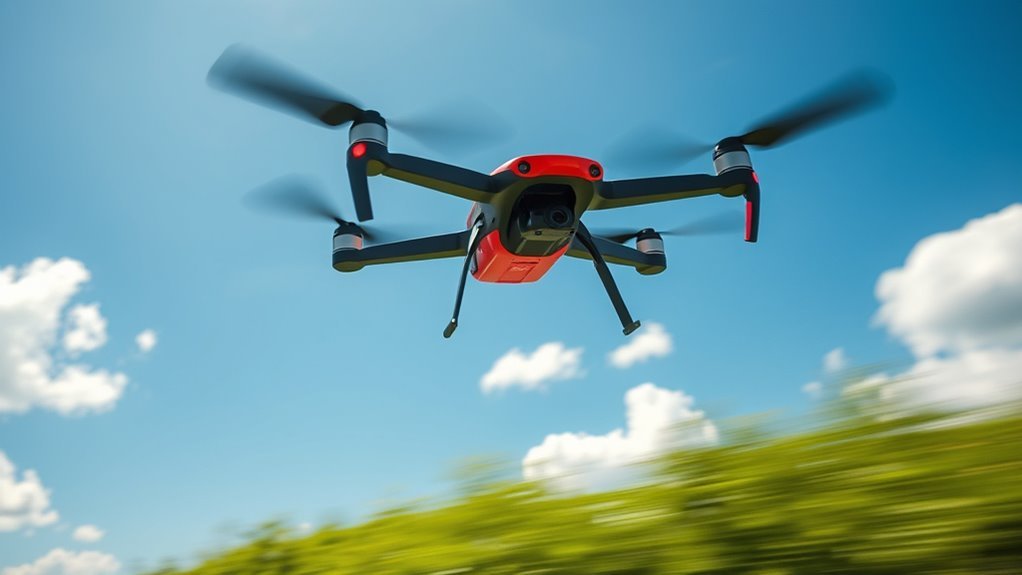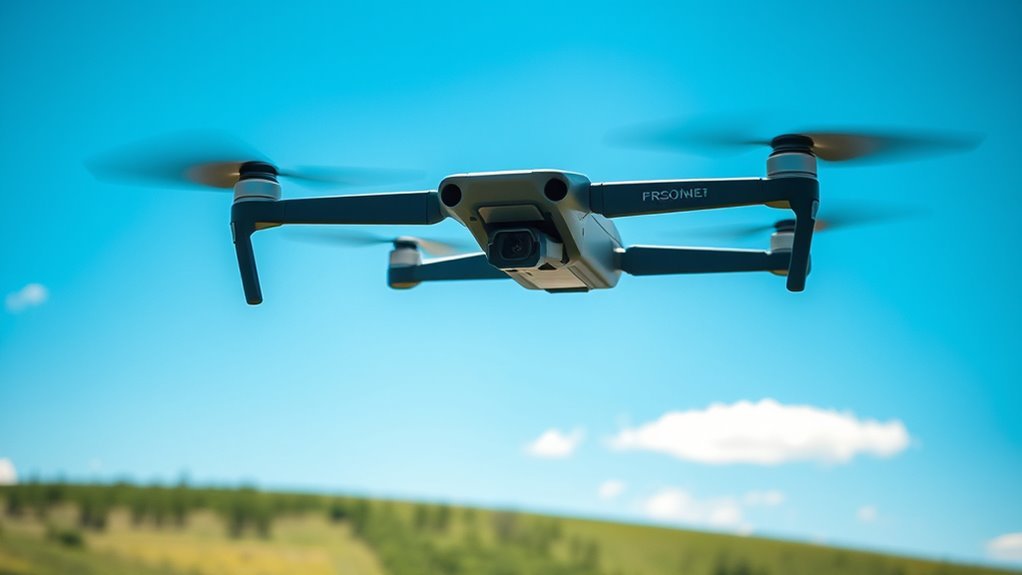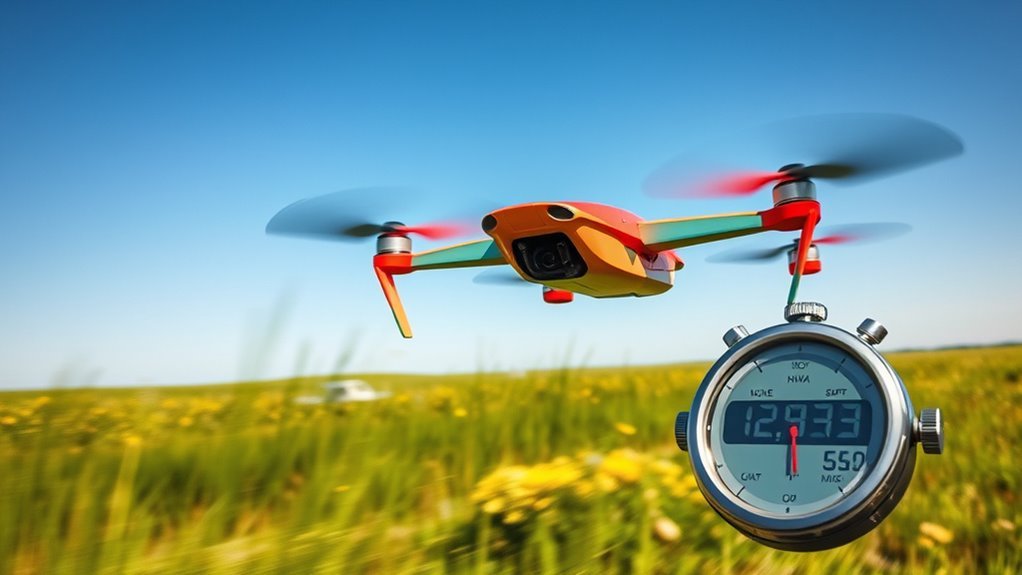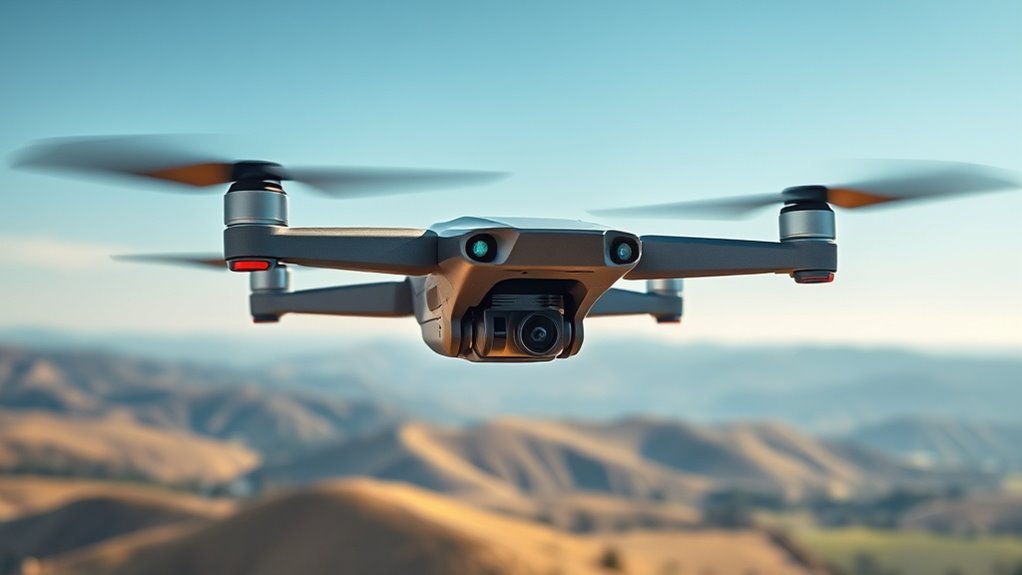You can reach speeds up to 87 mph with high-performance consumer drones like the DJI FPV, which combine powerful brushless motors and aerodynamic designs. Typical photography drones max out near 35–40 mph, prioritizing stability over speed. Variables such as motor power, weight, aerodynamics, and battery efficiency critically determine velocity and flight duration. Understanding these factors and how racing drones achieve top speeds beyond 70 mph reveals the fascinating balance between speed, control, and endurance.
Top Speed Records of Popular Consumer Drones

When evaluating the top speed records of popular consumer drones, you’ll find that performance varies considerably across models and manufacturers. The speed competition among leading brands like DJI, Parrot, and Autel has driven innovations resulting in notable speed records. For instance, DJI’s FPV drone reaches speeds up to 87 mph, setting a benchmark for agility and velocity in consumer-grade technology. Meanwhile, Parrot’s Anafi drone offers a more moderate top speed near 35 mph, emphasizing stability and endurance. These disparities highlight how manufacturers prioritize different performance characteristics based on intended use. As you explore these speed records, consider how each drone’s engineering—motor power, aerodynamics, and weight distribution—contributes to its ultimate velocity, empowering your freedom to choose a model that maximizes your aerial speed experience.
Factors Affecting Drone Speed

Although drone speed is often highlighted as a key performance metric, several technical factors determine how fast a consumer drone can fly. You’ll want to take into account drone aerodynamics, as streamlined designs reduce drag, allowing for higher velocities. Weight distribution also plays an essential role; balanced mass enhances stability and responsiveness, directly influencing speed capabilities. Additionally, motor power and battery efficiency dictate the thrust and endurance you can achieve. Propeller size and pitch affect lift and acceleration, while environmental conditions such as wind resistance impact actual flight speed. Understanding these elements helps you optimize for both performance and freedom in the air.
| Factor | Impact on Speed |
|---|---|
| Drone Aerodynamics | Minimizes drag for faster flight |
| Weight Distribution | Improves stability and control |
| Motor Power | Determines thrust and acceleration |
| Battery Efficiency | Influences flight duration and power |
| Propeller Design | Affects lift and thrust efficiency |
Comparing Racing Drones and Photography Drones

Two primary categories dominate the consumer drone market: racing drones and photography drones, each engineered with distinct priorities that affect their speed and performance. Racing drone features prioritize lightweight frames, high-thrust motors, and minimal aerodynamic drag, enabling rapid acceleration and top speeds often exceeding 70 mph. These drones sacrifice stability systems to reduce weight and latency, granting you maximum maneuverability and speed for competitive freedom. Conversely, photography drones emphasize stability through advanced gimbals, GPS-assisted hovering, and flight controllers designed for smoothness and control. This focus on photography drone stability inherently limits their top speed, typically capping around 40 mph, to guarantee steady footage and precise positioning. Understanding these fundamental differences helps you select a drone aligned with whether you value blistering speed or dependable aerial imaging.
How Drone Design Influences Velocity
Because drone velocity hinges on multiple interrelated factors, understanding design elements is vital to grasping their speed capabilities. You’ll find that aerodynamic shapes minimize drag, while ideal weight distribution enhances agility and acceleration. Motor efficiency and propeller design directly affect thrust generation, essential for top speeds. Material selection and structural integrity guarantee durability without excess mass, preserving velocity potential. Stability features and design innovations contribute to maintaining control at high speeds.
| Design Element | Effect on Velocity | Key Considerations |
|---|---|---|
| Aerodynamic Shapes | Reduces air resistance | Streamlined profiles |
| Weight Distribution | Improves maneuverability | Balanced center of gravity |
| Motor Efficiency | Maximizes thrust | Power-to-weight ratio |
| Material Selection | Minimizes weight | Lightweight composites |
| Propeller Design | Enhances propulsion | Blade pitch and size |
Master these, and you achieve superior speed freedom.
Impact of Speed on Battery Life and Flight Time
When you push a drone to higher speeds, its battery drains more rapidly due to increased power demands on the motors and electronic systems. This accelerated energy consumption directly reduces battery efficiency, forcing a trade-off between velocity and flight duration. As speed rises, aerodynamic drag grows exponentially, requiring more thrust and consequently more current draw from the battery. Consequently, the drone’s operational time in the air shortens, limiting your freedom to explore or capture extended footage. Understanding this relationship allows you to optimize flight plans, balancing speed with battery capacity to maximize effective flight duration. If you prioritize sustained flight, maintaining moderate speeds enhances battery efficiency, whereas pushing toward top speeds demands accepting reduced airtime as an inherent limitation of current consumer drone technology.
Safety Considerations When Flying High-Speed Drones
When flying high-speed drones, you need to strictly adhere to regulatory compliance requirements to avoid legal issues. Implementing risk management techniques is essential to minimize potential hazards during rapid maneuvers. Additionally, using appropriate protective gear can considerably reduce injury risk in case of accidents.
Regulatory Compliance Requirements
Although high-speed drones offer impressive performance, adhering to regulatory compliance requirements is essential to guarantee safe operation. Steering through complex regulatory frameworks and overcoming compliance challenges assures your drone flights remain lawful and secure. You must understand and respect no-fly zones, altitude limits, and licensing mandates. Here are key compliance points to keep in mind:
- Register your drone with relevant aviation authorities.
- Fly within visual line-of-sight to maintain control and avoid collisions.
- Observe maximum speed and altitude restrictions set by regulators.
- Avoid flying near airports, crowded areas, or restricted airspace.
Risk Management Techniques
Since high-speed drones operate at velocities that increase the potential for accidents, implementing robust risk management techniques is vital to guarantee safe flight operations. You need to conduct thorough risk assessment before each flight, evaluating environmental conditions, potential obstacles, and drone performance limits. Speed management plays a significant role; by calibrating your drone to maintain controllable velocities suited to the surrounding airspace, you reduce the chance of loss of control. Additionally, setting predefined speed thresholds based on operational context helps mitigate risks without compromising your freedom to maneuver. Continuously monitoring telemetry data enables real-time adjustments, ensuring safety margins are preserved. Fundamentally, adopting systematic risk assessment combined with disciplined speed management empowers you to exploit high-speed drone capabilities responsibly and confidently.
Protective Gear Importance
Managing risks effectively sets the foundation, but protecting yourself and others remains a top priority when operating high-speed drones. Adhering to safety regulations demands the consistent use of appropriate protective gear to mitigate injury risks from drone malfunctions or collisions. You’ll want to focus on:
- Impact-resistant goggles to shield your eyes from debris or drone parts
- Durable gloves that provide grip and protect hands during emergency handling
- High-visibility clothing to guarantee you remain noticeable in varied environments
- Sturdy footwear to guard against uneven terrain and enable quick movement
Future Trends in Consumer Drone Speeds
You’ll see future consumer drones leveraging emerging propulsion technologies like advanced brushless motors and lightweight composite materials to push speed limits further. AI-driven speed optimization will enable drones to adjust velocity dynamically based on environmental data and battery efficiency. These innovations promise significant gains in speed while maintaining stability and safety.
Emerging Propulsion Technologies
Although current consumer drones rely heavily on electric motors paired with lithium-polymer batteries, emerging propulsion technologies promise to greatly enhance speed capabilities. You’ll see propulsion advancements focused on improving power-to-weight ratios and energy efficiency, directly impacting top speeds. These innovations aim to break current limits, providing you with more freedom in flight dynamics.
Key propulsion advancements include:
- Brushless DC motors with higher torque density
- Solid-state batteries offering increased energy density
- Hybrid propulsion systems combining electric and fuel-based power
- Advanced cooling methods to sustain higher motor RPMs
AI-Driven Speed Optimization
Building on propulsion breakthroughs, AI-driven speed optimization is set to redefine drone performance by analyzing real-time flight data to fine-tune motor output and aerodynamic control surfaces. You’ll experience enhanced flight efficiency as AI algorithms leverage speed metrics and predictive modeling to execute real time adjustments. These adaptive systems employ advanced optimization techniques, enabling continuous performance analysis that pushes your drone’s velocity limits safely and precisely.
| Parameter | AI Role | Impact on Speed |
|---|---|---|
| Motor Output | Real-time adjustments | Maximizes thrust |
| Aerodynamics | Control surface tuning | Reduces drag |
| Flight Path | Predictive modeling | Optimizes trajectory |
| Energy Consumption | Performance analysis | Extends flight time |
This fusion of AI and mechanics grants you unmatched freedom to explore at unprecedented speeds.

